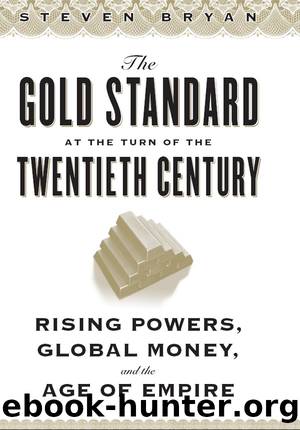The Gold Standard at the Turn of the Twentieth Century by Steven Bryan

Author:Steven Bryan [Bryan, Steven]
Language: eng
Format: epub
Tags: History, World
ISBN: 9780231152525
Google: RcTp2ZssIKoC
Publisher: Columbia University Press
Published: 2010-01-15T01:11:22+00:00
Sekai-teki to naru: The Meaning of Globalization
Whether one marks the end of the turn-of-the-century age of globalization with World War I or the Depression of the 1930s, it was the gold standard that rested at the center both of its emergence and its ultimate decline. And it was a very particular kind of globalization that carried with it a choice of one set of geographical influences over another. It was also riddled with the competing interplay of midcentury English political economy and late-century imperialism and protectionism. Nowhere was this more apparent than in Japan where the attempt to adapt to world standards could not do away with the fact that Japanâs economy existed simultaneously within two separate world currency regimesâsilver Asia and gold Europe. Nor could it avoid the fact that the adoption of midcentury English liberal forms was meant to serve the purposes of late nineteenth-century empire.
Switching from silver to gold also opened Japan to a new array of financial influences from Europe and the United States from which it had previously been isolated. After European and American military threats in the 1850s and 1860s, foreign influences on the Japanese economy took a less militaristic turn prior to the Sino-Japanese War, at which point militarism became much more of a two-way street.
In the late nineteenth century these economic changes made themselves directly felt in two ways: changes in overseas demand for Japanese silk and changes in the price of silver, which in turn directly affected silk demand. Demand for Japanese silk overseas in the 1890s had briefly declined due to improvements in Italian silk cultivation and appreciating silver. Then it increased dramatically due to the worldwide economic upturn and silverâs depreciation. Silverâs price, in turn, had fluctuated increasingly in the 1890s due to Indiaâs currency changes, decline in silver demand in India and other countries, and changes in silver production, which magnified increased demand for silk.
More general political and economic events overseas had trade effects as well. The 1892 and 1896 U.S presidential elections, with their impact on world silver and gold prices, political tensions in Europe, and the ups and downs of overseas financial markets all had worldwide effects. The effects on Japan, however, stopped at the level of trade. There was virtually no overflow in terms of finance. Throughout most of the preceding thirty years, Meiji Japan had essentially been on a silver standard no matter what the nominal system was at any time. During this period Japan had experienced significant industrial growth internally and export and commercial expansion externally. Only in terms of finance was Japan cut off from foreign countries. But capital was in high demand and interest rates had been high. Although outflows of capital overseas had ceased, there had not been large inflows. In short, Japanâs economic relations with foreign countries had been limited to trade.
This isolation from the more volatile European and American financial markets had its advantages. When the U.S. financial panic of 1893 rippled to London and other European financial markets, Japan remained largely unaffected.
Download
This site does not store any files on its server. We only index and link to content provided by other sites. Please contact the content providers to delete copyright contents if any and email us, we'll remove relevant links or contents immediately.
International Integration of the Brazilian Economy by Elias C. Grivoyannis(74426)
The Radium Girls by Kate Moore(11616)
Turbulence by E. J. Noyes(7694)
Nudge - Improving Decisions about Health, Wealth, and Happiness by Thaler Sunstein(7238)
The Black Swan by Nassim Nicholas Taleb(6760)
Rich Dad Poor Dad by Robert T. Kiyosaki(6173)
Pioneering Portfolio Management by David F. Swensen(6074)
Man-made Catastrophes and Risk Information Concealment by Dmitry Chernov & Didier Sornette(5643)
Zero to One by Peter Thiel(5487)
Secrecy World by Jake Bernstein(4387)
Millionaire: The Philanderer, Gambler, and Duelist Who Invented Modern Finance by Janet Gleeson(4089)
The Age of Surveillance Capitalism by Shoshana Zuboff(3980)
Skin in the Game by Nassim Nicholas Taleb(3965)
The Money Culture by Michael Lewis(3842)
Bullshit Jobs by David Graeber(3826)
Skin in the Game: Hidden Asymmetries in Daily Life by Nassim Nicholas Taleb(3720)
The Dhandho Investor by Mohnish Pabrai(3560)
The Wisdom of Finance by Mihir Desai(3523)
Blockchain Basics by Daniel Drescher(3326)
